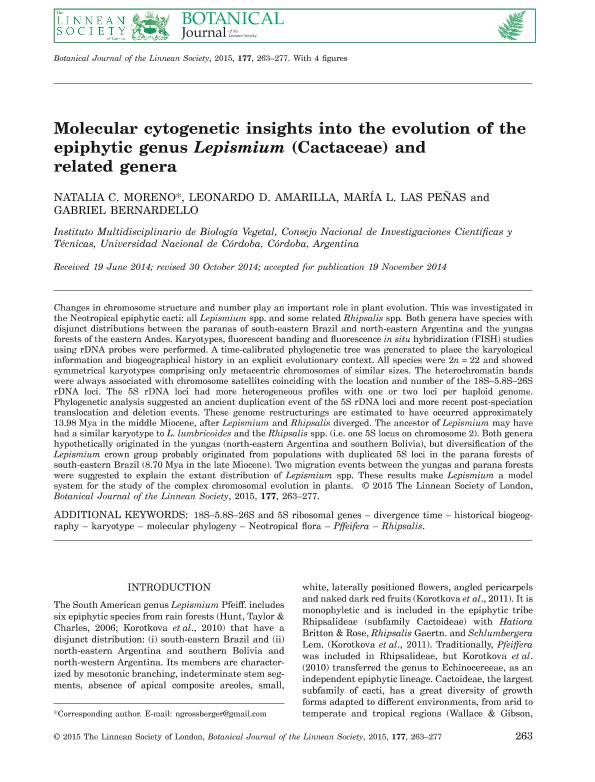Mostrar el registro sencillo del ítem
dc.contributor.author
Moreno, Natalia Cecilia

dc.contributor.author
Amarilla, Leonardo

dc.contributor.author
Las Peñas, Maria Laura

dc.contributor.author
Bernardello, Gabriel Luis Mario

dc.date.available
2017-04-28T14:21:50Z
dc.date.issued
2015-02
dc.identifier.citation
Moreno, Natalia Cecilia; Amarilla, Leonardo; Las Peñas, Maria Laura; Bernardello, Gabriel Luis Mario; Molecular cytogenetic insights into the evolution of the epiphytic genus Lepismium (Cactaceae) and related genera; The Linnean Society of London; Botanical Journal Of The Linnean Society; 177; 2; 2-2015; 263-277
dc.identifier.issn
0024-4074
dc.identifier.uri
http://hdl.handle.net/11336/15831
dc.description.abstract
Changes in chromosome structure and number play an important role in plant evolution. This was investigated in the Neotropical epiphytic cacti: all Lepismium spp. and some related Rhipsalis spp. Both genera have species with disjunct distributions between the paranas of south-eastern Brazil and north-eastern Argentina and the yungas forests of the eastern Andes. Karyotypes, fluorescent banding and fluorescence in situ hybridization (FISH) studies using rDNA probes were performed. A time-calibrated phylogenetic tree was generated to place the karyological information and biogeographical history in an explicit evolutionary context. All species were 2n = 22 and showed symmetrical karyotypes comprising only metacentric chromosomes of similar sizes. The heterochromatin bands were always associated with chromosome satellites coinciding with the location and number of the 18S?5.8S?26S rDNA loci. The 5S rDNA loci had more heterogeneous profiles with one or two loci per haploid genome. Phylogenetic analysis suggested an ancient duplication event of the 5S rDNA loci and more recent post-speciation translocation and deletion events. These genome restructurings are estimated to have occurred approximately 13.98 Mya in the middle Miocene, after Lepismium and Rhipsalis diverged. The ancestor of Lepismium may have had a similar karyotype to L. lumbricoides and the Rhipsalis spp. (i.e. one 5S locus on chromosome 2). Both genera hypothetically originated in the yungas (north-eastern Argentina and southern Bolivia), but diversification of the Lepismium crown group probably originated from populations with duplicated 5S loci in the parana forests of south-eastern Brazil (8.70 Mya in the late Miocene). Two migration events between the yungas and parana forests were suggested to explain the extant distribution of Lepismium spp. These results make Lepismium a model system for the study of the complex chromosomal evolution in plants.
dc.format
application/pdf
dc.language.iso
eng
dc.publisher
The Linnean Society of London
dc.rights
info:eu-repo/semantics/openAccess
dc.rights.uri
https://creativecommons.org/licenses/by-nc-sa/2.5/ar/
dc.subject
18s–5.8s–26s And 5s Ribosomal Genes
dc.subject
Divergence Time
dc.subject
Historical Biogeography
dc.subject
Karyotype
dc.subject
Molecular Phylogeny
dc.subject
Neotropical Flora
dc.subject
Pffeifera
dc.subject
Rhipsalis
dc.subject.classification
Ciencias de las Plantas, Botánica

dc.subject.classification
Ciencias Biológicas

dc.subject.classification
CIENCIAS NATURALES Y EXACTAS

dc.title
Molecular cytogenetic insights into the evolution of the epiphytic genus Lepismium (Cactaceae) and related genera
dc.type
info:eu-repo/semantics/article
dc.type
info:ar-repo/semantics/artículo
dc.type
info:eu-repo/semantics/publishedVersion
dc.date.updated
2017-04-26T18:37:45Z
dc.identifier.eissn
1095-8339
dc.journal.volume
177
dc.journal.number
2
dc.journal.pagination
263-277
dc.journal.pais
Reino Unido

dc.journal.ciudad
Londres
dc.description.fil
Fil: Moreno, Natalia Cecilia. Consejo Nacional de Investigaciones Científicas y Técnicas. Centro Científico Tecnológico Conicet - Córdoba. Instituto Multidisciplinario de Biología Vegetal. Universidad Nacional de Córdoba. Facultad de Ciencias Exactas Físicas y Naturales. Instituto Multidisciplinario de Biología Vegetal; Argentina
dc.description.fil
Fil: Amarilla, Leonardo. Consejo Nacional de Investigaciones Científicas y Técnicas. Centro Científico Tecnológico Conicet - Córdoba. Instituto Multidisciplinario de Biología Vegetal. Universidad Nacional de Córdoba. Facultad de Ciencias Exactas Físicas y Naturales. Instituto Multidisciplinario de Biología Vegetal; Argentina
dc.description.fil
Fil: Las Peñas, Maria Laura. Consejo Nacional de Investigaciones Científicas y Técnicas. Centro Científico Tecnológico Conicet - Córdoba. Instituto Multidisciplinario de Biología Vegetal. Universidad Nacional de Córdoba. Facultad de Ciencias Exactas Físicas y Naturales. Instituto Multidisciplinario de Biología Vegetal; Argentina
dc.description.fil
Fil: Bernardello, Gabriel Luis Mario. Consejo Nacional de Investigaciones Científicas y Técnicas. Centro Científico Tecnológico Conicet - Córdoba. Instituto Multidisciplinario de Biología Vegetal. Universidad Nacional de Córdoba. Facultad de Ciencias Exactas Físicas y Naturales. Instituto Multidisciplinario de Biología Vegetal; Argentina
dc.journal.title
Botanical Journal Of The Linnean Society

dc.relation.alternativeid
info:eu-repo/semantics/altIdentifier/url/http://onlinelibrary.wiley.com/doi/10.1111/boj.12242/abstract
dc.relation.alternativeid
info:eu-repo/semantics/altIdentifier/doi/http://dx.doi.org/10.1111/boj.12242
Archivos asociados
